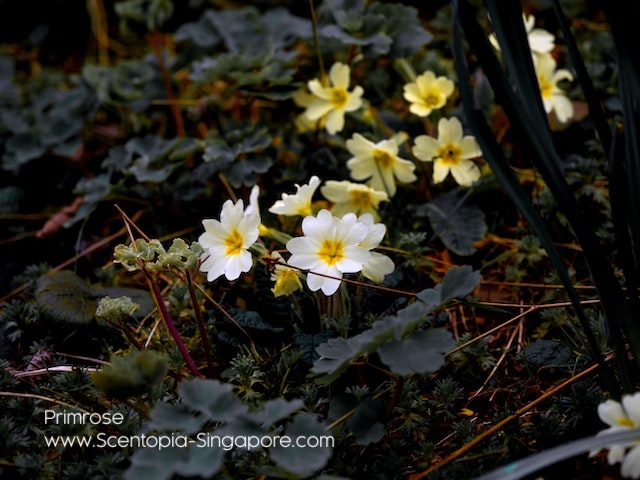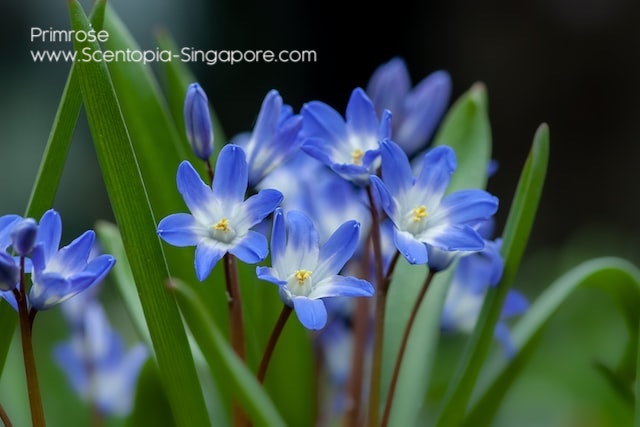Embrace the Delicate Aroma of Primrose Fragrance
Primrose: The Enchanting Blossom of Perfumes, Healing, and Culinary Delights
Introduction: Primrose, with its delicate and enchanting blossoms, is a captivating flower celebrated for its subtle fragrance, potential therapeutic properties, and culinary uses. Scientifically known as Primula, this lovely flower belongs to the Primulaceae family and has been cherished by various cultures for centuries. From inspiring perfumers with its alluring scent to offering potential benefits in therapeutic oils and culinary delights, primrose is more than just a flower. This essay delves into the captivating world of primrose, encompassing its presence in perfumes, therapeutic oils, food, medicinal systems, historical significance, and intriguing fun facts about this extraordinary and cherished blossom.
The Enchantment of Primrose: Primrose flowers are renowned for their delicate petals and a wide array of vibrant colors, making them popular choices in gardens and floral arrangements. Their subtle fragrance, potential therapeutic properties, and culinary versatility add to their enigmatic allure.
Perfumes and Fragrance: While primrose is not commonly used in perfumery to extract essential oils, its subtle and enchanting fragrance has inspired perfumers to create scents that capture the essence of this lovely flower. Primrose-inspired perfumes often evoke feelings of grace, elegance, and femininity.
Therapeutic Oils and Aromatherapy: Primrose essential oil is not widely available, but certain therapeutic oils with floral characteristics, such as rose or lavender essential oil, may be used in aromatherapy to promote relaxation, reduce stress, and uplift the mood.
Medicinal Applications: Primrose has a history of use in traditional medicine systems. Primrose oil, derived from the seeds of some primrose species, is rich in gamma-linolenic acid (GLA), which is believed to have potential anti-inflammatory and skin-nourishing properties.
Culinary Delights: Primrose flowers are edible and have been used in culinary creations. They can be used as garnishes on salads, desserts, and other dishes, adding a touch of color and elegance to the presentation.
Historical Significance: Primrose has a rich history in various cultural and symbolic contexts. In ancient times, it was associated with love and youthfulness and was often used in love potions and herbal remedies.
Fun and Crazy Facts:
Primrose, with its delicate beauty, subtle fragrance, and potential therapeutic properties, is an enchanting flower that has captivated cultures throughout history. From its presence in perfumes to its potential uses in aromatherapy and traditional medicine, primrose offers a wealth of enjoyment and historical significance. As we admire the delicate petals and symbolic meaning of primrose and explore its cultural significance, we are reminded of the enduring allure and timeless charm of this extraordinary blossom that continues to inspire us with its grace and elegance.
Introduction: Primrose, with its delicate and enchanting blossoms, is a captivating flower celebrated for its subtle fragrance, potential therapeutic properties, and culinary uses. Scientifically known as Primula, this lovely flower belongs to the Primulaceae family and has been cherished by various cultures for centuries. From inspiring perfumers with its alluring scent to offering potential benefits in therapeutic oils and culinary delights, primrose is more than just a flower. This essay delves into the captivating world of primrose, encompassing its presence in perfumes, therapeutic oils, food, medicinal systems, historical significance, and intriguing fun facts about this extraordinary and cherished blossom.
The Enchantment of Primrose: Primrose flowers are renowned for their delicate petals and a wide array of vibrant colors, making them popular choices in gardens and floral arrangements. Their subtle fragrance, potential therapeutic properties, and culinary versatility add to their enigmatic allure.
Perfumes and Fragrance: While primrose is not commonly used in perfumery to extract essential oils, its subtle and enchanting fragrance has inspired perfumers to create scents that capture the essence of this lovely flower. Primrose-inspired perfumes often evoke feelings of grace, elegance, and femininity.
Therapeutic Oils and Aromatherapy: Primrose essential oil is not widely available, but certain therapeutic oils with floral characteristics, such as rose or lavender essential oil, may be used in aromatherapy to promote relaxation, reduce stress, and uplift the mood.
Medicinal Applications: Primrose has a history of use in traditional medicine systems. Primrose oil, derived from the seeds of some primrose species, is rich in gamma-linolenic acid (GLA), which is believed to have potential anti-inflammatory and skin-nourishing properties.
Culinary Delights: Primrose flowers are edible and have been used in culinary creations. They can be used as garnishes on salads, desserts, and other dishes, adding a touch of color and elegance to the presentation.
Historical Significance: Primrose has a rich history in various cultural and symbolic contexts. In ancient times, it was associated with love and youthfulness and was often used in love potions and herbal remedies.
Fun and Crazy Facts:
- Primrose Primatology: The name "primrose" is believed to come from the Latin word "prima rosa," meaning "first rose," as primrose flowers are often some of the first blooms to appear in spring.
- Primrose Folklore: In some cultures, primrose flowers were believed to have magical properties and were used in rituals and celebrations.
- Primrose Species: There are over 500 different species of primrose, each with its unique characteristics and geographical distribution.
- Primrose in Literature: Primroses have been mentioned in various literary works, including Shakespeare's plays and children's stories like "The Tale of Peter Rabbit" by Beatrix Potter.
- Primrose Medicinal Uses: Primrose has been historically used to treat various ailments, including respiratory issues, skin conditions, and digestive disorders.
Primrose, with its delicate beauty, subtle fragrance, and potential therapeutic properties, is an enchanting flower that has captivated cultures throughout history. From its presence in perfumes to its potential uses in aromatherapy and traditional medicine, primrose offers a wealth of enjoyment and historical significance. As we admire the delicate petals and symbolic meaning of primrose and explore its cultural significance, we are reminded of the enduring allure and timeless charm of this extraordinary blossom that continues to inspire us with its grace and elegance.
To experience augmented reality, please open the Facebook-app using QR code and point to the image below
Primrose Fragrance Collection: Where Beauty Meets Aromatherapy
The primrose (Primula) is a genus of flowering plants that belong to the Primulaceae family. These plants are native to the Northern Hemisphere and are known for their brightly colored, cup-shaped flowers that come in a range of colors, including yellow, pink, purple, red, and white.
Primroses are popular garden plants and are often grown for their bright, cheerful flowers and attractive foliage. They are low-growing plants that are well suited to rock gardens, border plantings, and woodland gardens. They can also be grown in pots and containers, making them a popular choice for indoor gardening.
In addition to their ornamental value, primroses have been used for medicinal purposes in some cultures. The leaves, roots, and flowers of some species of primroses are used to treat various ailments, including skin problems, digestive problems, and respiratory problems. However, it's worth noting that these uses are not well supported by scientific evidence, and primroses should not be used as a substitute for conventional medical treatment.
Overall, primroses are hardy, low-maintenance plants that are a popular choice for gardeners and indoor gardeners alike. Their bright, cheerful flowers and attractive foliage make them a great addition to any garden or home.
The primrose is native to the Northern Hemisphere and has been found growing wild in many regions, including Europe, Asia, and North America. The plant was well known to the ancient Greeks and Romans, who valued it for its bright, cheerful flowers and medicinal properties.
In medieval Europe, the primrose was associated with the celebration of spring and was often used as a symbol of renewal and hope. During this time, the plant was widely cultivated and was used for medicinal purposes, as well as for ornamental purposes.
In the 19th and 20th centuries, the primrose became a popular garden plant and was introduced to many other parts of the world. Today, the primrose is widely cultivated and is grown in many different forms, including single-flowered and double-flowered varieties, as well as cultivars with variegated foliage.
Overall, the primrose has a long and rich history and continues to be a popular and beloved garden plant. Its bright, cheerful flowers and attractive foliage make it a great choice for gardeners and indoor gardeners alike.
Primroses are popular garden plants and are often grown for their bright, cheerful flowers and attractive foliage. They are low-growing plants that are well suited to rock gardens, border plantings, and woodland gardens. They can also be grown in pots and containers, making them a popular choice for indoor gardening.
In addition to their ornamental value, primroses have been used for medicinal purposes in some cultures. The leaves, roots, and flowers of some species of primroses are used to treat various ailments, including skin problems, digestive problems, and respiratory problems. However, it's worth noting that these uses are not well supported by scientific evidence, and primroses should not be used as a substitute for conventional medical treatment.
Overall, primroses are hardy, low-maintenance plants that are a popular choice for gardeners and indoor gardeners alike. Their bright, cheerful flowers and attractive foliage make them a great addition to any garden or home.
The primrose is native to the Northern Hemisphere and has been found growing wild in many regions, including Europe, Asia, and North America. The plant was well known to the ancient Greeks and Romans, who valued it for its bright, cheerful flowers and medicinal properties.
In medieval Europe, the primrose was associated with the celebration of spring and was often used as a symbol of renewal and hope. During this time, the plant was widely cultivated and was used for medicinal purposes, as well as for ornamental purposes.
In the 19th and 20th centuries, the primrose became a popular garden plant and was introduced to many other parts of the world. Today, the primrose is widely cultivated and is grown in many different forms, including single-flowered and double-flowered varieties, as well as cultivars with variegated foliage.
Overall, the primrose has a long and rich history and continues to be a popular and beloved garden plant. Its bright, cheerful flowers and attractive foliage make it a great choice for gardeners and indoor gardeners alike.
Shop Floral Perfumes Online at Scentopia Singapore
Here are some fun facts about the primrose (Primula):
- Symbol of Spring: The primrose is often associated with the arrival of spring, and its brightly colored flowers are often seen as a symbol of hope and renewal.
- Wide Range of Colors: Primroses come in a range of colors, including yellow, pink, purple, red, and white. Some species are also bi-colored or multi-colored, adding to their ornamental appeal.
- Medicinal Properties: In some cultures, primroses have been used for medicinal purposes. The leaves, roots, and flowers of some species are used to treat various ailments, including skin problems, digestive problems, and respiratory problems.
- Edible Flowers: The flowers of some species of primroses are edible and are often used in salads or as a garnish.
- Easy to Grow: Primroses are easy to grow and are well suited to rock gardens, border plantings, and woodland gardens. They can also be grown in pots and containers, making them a popular choice for indoor gardening.
- Long Blooming Period: Primroses are long-blooming plants and can provide a colorful display of flowers for several weeks.
- Attractive Foliage: In addition to their brightly colored flowers, primroses also have attractive foliage that adds to their ornamental appeal.
The Art of Crafting Primrose Fragrance
Primroses (Primula) have been depicted in art and culture for thousands of years and have been used to symbolise various themes and ideas. Here are a few examples:
In some religious traditions, primroses (Primula) have symbolic meaning and significance. Here are a few examples:
- Spring: In many cultures, primroses are associated with the arrival of spring and their brightly coloured flowers are seen as a symbol of hope and renewal.
- Love and Affection: In some cultures, primroses are associated with love and affection. They have been given as gifts to symbolise love and admiration, and their bright, cheerful flowers have been used to decorate romantic settings.
- Literature: Primroses have been featured in literature for centuries, and their bright, cheerful flowers have been used as symbols of hope, renewal, and beauty.
- Botanical Art: Primroses have been depicted in botanical art for centuries, and their bright, colourful flowers have been used to create beautiful and detailed illustrations
In some religious traditions, primroses (Primula) have symbolic meaning and significance. Here are a few examples:
- Christianity: In Christianity, primroses are associated with Easter and are often used as symbols of renewal and hope.
- Hinduism: In Hinduism, primroses are associated with the spring festival of Holi, which celebrates the arrival of spring and the victory of good over evil.
- Paganism: In some pagan traditions, primroses are associated with the goddess of spring and are seen as symbols of new beginnings, fertility, and growth.
Aromatic Bliss: Exploring Delicate Floral Aroma
In some cultures, primroses (Primula) have been used for their therapeutic properties. Here are a few examples:
- Medicinal Properties: Some species of primroses have been used for medicinal purposes, particularly for the treatment of skin problems, digestive problems, and respiratory problems. The leaves, roots, and flowers of these plants are used to make teas, tinctures, and ointments.
- Aromatherapy: Some species of primroses have a sweet, fresh scent that is believed to have a calming and relaxing effect. The essential oils extracted from these plants are sometimes used in aromatherapy to promote feelings of relaxation and well-being.
- Skin Care: The petals of some species of primroses are rich in essential fatty acids, which are beneficial for the skin. Primrose oil is often used as a moisturizer and is believed to help improve the health and appearance of the skin.
Elevate Your Scent Experience with Primrose Fragrance
The scent profile of primroses (Primula) varies depending on the species and variety, but many species have a sweet, fresh, and slightly floral fragrance. Some species have a light, delicate scent, while others have a more pronounced fragrance that can be described as fresh and earthy.
Some species of primroses are known for their aromatherapeutic properties, and their essential oils are sometimes used in aromatherapy to promote relaxation and well-being. The scent of these oils is often described as sweet, fresh, and slightly floral, with a light, delicate quality that is soothing and calming.
Overall, the scent profile of primroses can vary depending on the species and variety, but many species have a sweet, fresh, and slightly floral fragrance that is pleasing and soothing.
The scent profile of primroses (Primula) is due to the presence of various volatile organic compounds (VOCs), including terpenes, esters, alcohols, and aldehydes. Here are a few examples:
Some species of primroses are known for their aromatherapeutic properties, and their essential oils are sometimes used in aromatherapy to promote relaxation and well-being. The scent of these oils is often described as sweet, fresh, and slightly floral, with a light, delicate quality that is soothing and calming.
Overall, the scent profile of primroses can vary depending on the species and variety, but many species have a sweet, fresh, and slightly floral fragrance that is pleasing and soothing.
The scent profile of primroses (Primula) is due to the presence of various volatile organic compounds (VOCs), including terpenes, esters, alcohols, and aldehydes. Here are a few examples:
- Terpenes: Terpenes, such as limonene, are responsible for the fresh, citrusy scent of many species of primroses.
- Esters: Esters, such as linalyl acetate, are responsible for the sweet, floral fragrance of many species of primroses.
- Alcohols: Alcohols, such as geraniol, are responsible for the fresh, floral fragrance of many species of primroses.
- Aldehydes: Aldehydes, such as citral, are responsible for the fresh, lemony scent of many species of primroses.
The Gift of Nature: Primrose Perfume Delight
There are many perfumes and fragrances that feature the scent of primroses (Primula) as a dominant note. Here are a few examples:
- Marc Jacobs Daisy Eau So Fresh: This light, fresh, and floral fragrance features primrose as one of its main notes, along with notes of strawberry, violet, and jasmine.
- Jo Malone London Lime Basil & Mandarin: This light, fresh, and citrusy fragrance features primrose as one of its main floral notes, along with notes of lime, basil, and mandarin.
- Chloé Love Story: This fresh, floral, and sensual fragrance features primrose as one of its main floral notes, along with notes of orange blossom, stephanotis, and jasmine.
- Guerlain Aqua Allegoria Lys Soleia: This light, fresh, and floral fragrance features primrose as one of its main floral notes, along with notes of lemon, grapefruit, and peony.
Join Scentopia, Sentosa's latest tourist attraction wonderful orchid scent crafting, fragrance tour, bridal shower or corporate team building which includes perfume making onsite and offsite, beach activities and more. We also serve primary school learning journey, secondary students and pupil on industrial excursions. Know more about our orchids perfume bar or therapeutic orchid scents and other wellness aromas. Conatct Perfume workshop or book a scent crafting session here.







